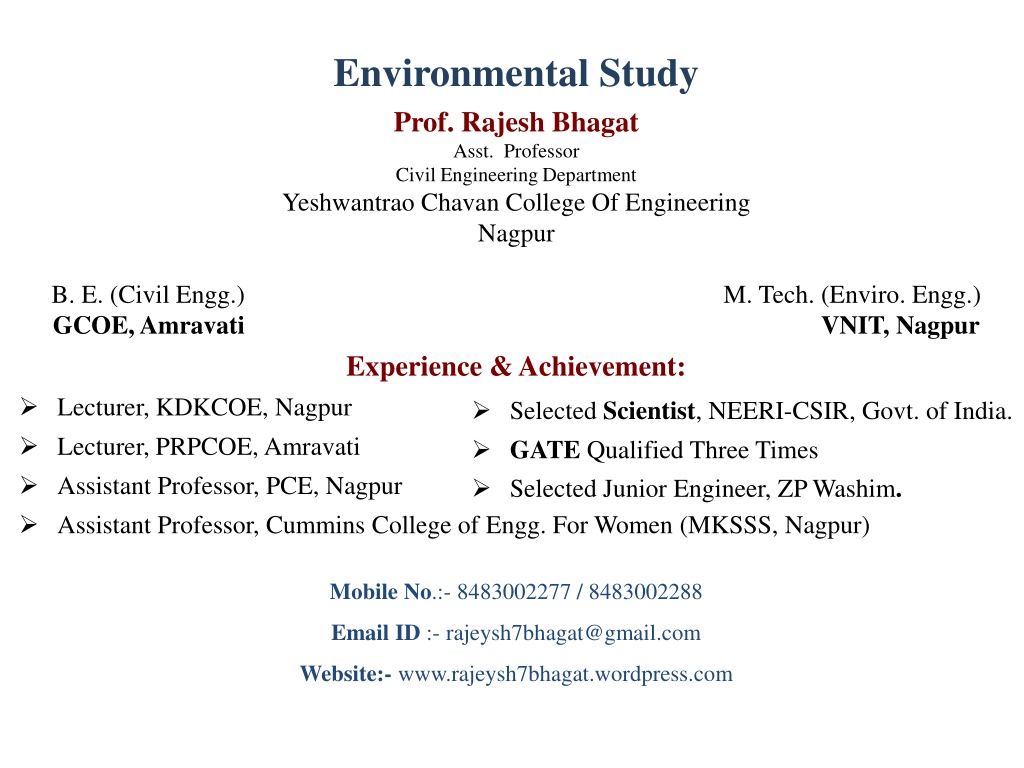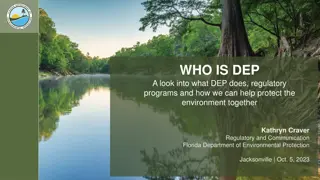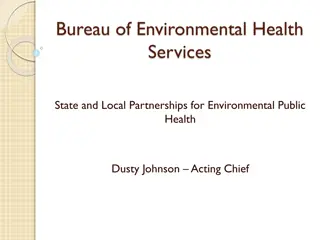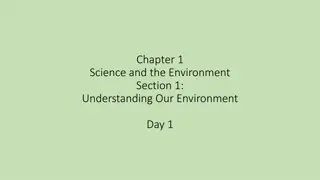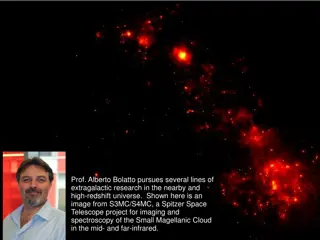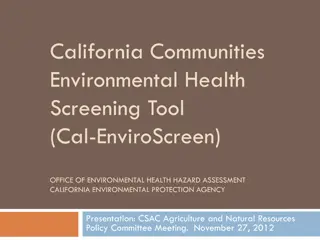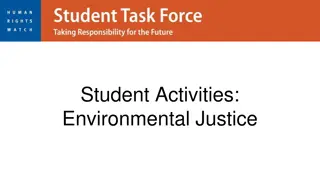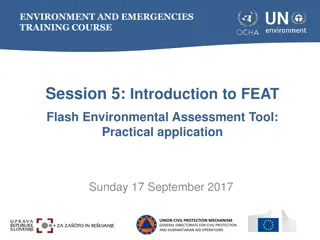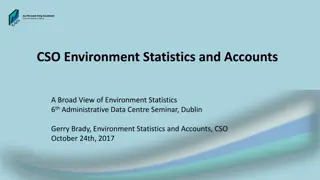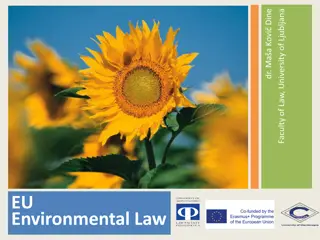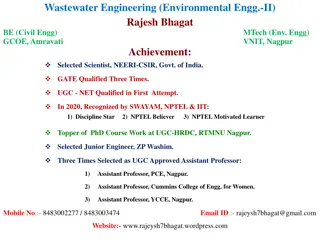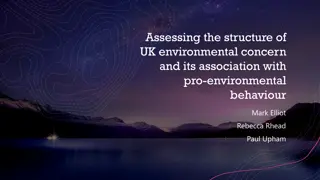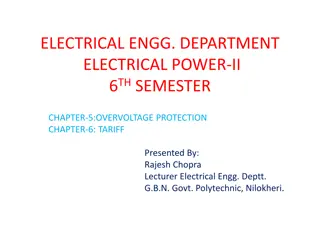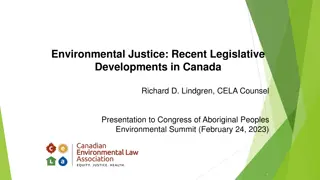Comprehensive Environmental Study Course Overview by Prof. Rajesh Bhagat
Explore the multifaceted world of environmental studies with Professor Rajesh Bhagat, covering topics such as natural resources, ecosystems, biodiversity, pollution, social issues, and environmental ethics. Gain insights into sustainable development, resource conservation, disaster management, and environmental legislation, all presented in a structured and informative manner.
Download Presentation

Please find below an Image/Link to download the presentation.
The content on the website is provided AS IS for your information and personal use only. It may not be sold, licensed, or shared on other websites without obtaining consent from the author. Download presentation by click this link. If you encounter any issues during the download, it is possible that the publisher has removed the file from their server.
E N D
Presentation Transcript
Environmental Study Prof. Rajesh Bhagat Asst. Professor Civil Engineering Department Yeshwantrao Chavan College Of Engineering Nagpur B. E. (Civil Engg.) GCOE, Amravati M. Tech. (Enviro. Engg.) VNIT, Nagpur Experience & Achievement: Lecturer, KDKCOE, Nagpur Lecturer, PRPCOE, Amravati Assistant Professor, PCE, Nagpur Assistant Professor, Cummins College of Engg. For Women (MKSSS, Nagpur) Selected Scientist, NEERI-CSIR, Govt. of India. GATE Qualified Three Times Selected Junior Engineer, ZP Washim. Mobile No.:- 8483002277 / 8483002288 Email ID :- rajeysh7bhagat@gmail.com Website:- www.rajeysh7bhagat.wordpress.com
UNIT I [ 6 Hrs.] Introduction: Definition, scope and importance; Need for public awareness -Institutions in environment, people in environment. Natural Resources: Renewable and non-renewable and associated problems; Role of an individual in conservation of natural resources; equitable use of resources for sustainable lifestyles. UNIT II [ 6 Hrs.] Ecosystems: Concept of an ecosystem - understanding ecosystems, ecosystem degradation, resource utilization, Structure and functions of an ecosystem- producers, consumers) and decomposers. Energy flow in the ecosystem - water, carbon, oxygen, nitrogen; and energy cycles, integration of cycles in nature. Ecological succession; Food chains, food webs and ecological pyramids; Ecosystem types - characteristic features, structure:, and functions of forest, grassland, desert and aquatic ecosystems.
UNIT III [ 6 Hrs.] Bio-diversity: Introduction - biodiversity; at genetic, species and ecosystem levels Bio- geographic classification of India Value of biodiversity - Consumptive use value, productive use .value, social, ethical, moral, aesthetic and optional value of biodiversity. India as a mega-diversity nation; hotspots of biodiversity Threats to bio-diversity - habitat loss, poaching of wildlife, man-wild life conflicts. Common endangered and endemic plant and animal species of India. Insitu and Exsitu conservation of Biodiversity UNIT IV [ 6 Hrs.] Pollution : Definition; Causes, effects and control measures of air, water, soil, marine, noise and thermal pollutions and nuclear hazards. Solid waste management - Causes, effects and control measures of urban and industrial waste. Role of individual and institutions in prevention of pollution. Disaster management Floods, Earth quacks, Cyclone and land slides.
UNIT V [ 6 Hrs.] Social Issues and the Environment: Unsustainable to sustainable development; Urban problems, related to energy; Water conservation, rainwater harvesting, watershed management; Problems and concerns of resettlement and rehabilitation of affected people. Environmental ethics - issues and possible solutions Resource consumption patterns and need for equitable utilization; Equity disparity in Western and Eastern countries; Urban and rural equity issues; need for gender- equity. Preserving Resources for future generations. The rights of animals; Ethical basis of environment education and awareness; Conservation ethics and traditional value systems of India. Climate change, global warming, acid-, rain, Ozone layer depletion, nuclear accidents and holocasts. Wasteland Reclamation; Consumerism and Waste products. Environment legislations - The Environment (protection) Act; The water (Prevention and Control of Pollution) Act; The. Wildlife Protection Act; Forest Conservation Act; Issues involved in enforcement of environmental legislations - environment impact assessment (EIA), Citizens actions and action groups. Public awareness Using an environmental calendar of activities, self initiation.
UNIT VI [ 6 Hrs.] Human Population and the Environment: Global population growth, variation among nations, population explosion; Family Welfare Programmes.- methods of. sterilization; Urbanization. Environment and human health- Climate and health, Infectious diseases, water-related diseases, risk due to chemicals in food, Cancer and environment. Human rights Equity, Nutrition and health rights, intellectual property rights (1PRS), Community Biodiversity registers (CBRs). Value education - environmental values, valuing nature, valuing cultures, social justice, human heritage, equitable use of resources, common property resources, ecological degradation. HIY/A1DS; Women and Child Welfare; Information technology in environment and human health.
What is Environment ? Natural world Surrounding in which we live Life sustaining system in which various living and non-living things are inter-related Collection of all the external factors or conditions influencing the life of the organisms 6
Scope Of The Environmental Studies: 1) To study the interrelationship between biotic and abiotic components. 2) To carry out the impact analysis and environmental audit in order to minimize the environmental problems. 3) Reduce the pollution. 4) Managing the unpredictable disaster. 5) To create awareness to the public. 6) It provides necessary information about biodiversity. 7) Environmental studies helps to find and solve the big environmental problems. 7
What is an ecosystem Three major principles of ecosystem Components of an ecosystem Abiotic components Biotic components Movement of energy and nutrients Food chain Food webs Trophic levels, biomass and biome Linkages and interactions in an ecosystem Carbon cycle and oxygen cycle Model of nutrient cycle Environmental Limitation in ecosystem development.
An ecosystem is a grouping of organisms that interact with each other and their environment in such a way as to preserve the grouping. There is a great variety of ecosystems in existence, all of them are characterized by general structural and functional attributes. An ecosystem is a community of living organisms in conjunction with the nonliving components of their environment (things like air, water and mineral soil), interacting as a system. These biotic and abiotic components are regarded as linked together through nutrient cycles and energy flows. As ecosystems are defined by the network of interactions among organisms, and between organisms and their environment, they can be of any size but usually encompass specific, limited spaces (although some scientists say that the entire planet is an ecosystem). Energy, water, nitrogen and soil minerals are other essential abiotic components of an ecosystem. The energy that flows through ecosystems is obtained primarily from the sun.
Three major principles of ecosystem Nutrient cycling: Movement of chemical elements from the environment into living organisms and from them back into the environment through organisms live, grow, die and decompose. Energy flow: Energy is required to transform inorganic nutrients into organic tissues of an organism. Energy is the driving force to the work of ecosystem. Structure It refers to the particular pattern of inter-relationships that exists between organisms in an ecosystem.
Ecosystem: Nutrient cycling, energy flow and structure
Abiotic components They form the environment and determine the type / structure of ecosystem. Sunlight (temperature) Nutrients Rainfall, minerals, carbon, nitrogen, .. Type of ecosystems: Tropical rainforest, Desert, Tundra, Grassland, ..
Biotic components Producers (Autotrophs): All green plants. They use solar energy, chlorophyll, inorganic nutrients and water to produce their own food. (Photosynthesis) Consumers: They consume the organic compounds in plant and animal tissues by eating. Herbivores (plant feeders) Carnivores (meat eaters) Omnivores (general feeders) Primary consumers Secondary consumers
Biotic components Decomposers They are tiny organisms includes bacteria and fungi, which turn organic compounds in dead plants and animals into inorganic materials. They cause the continual recirculation of chemicals within ecosystem (nutrient cycle)
Movement of energy and nutrients Food chain Food webs Trophic level, biomass and biome
Food Chain The particular pathway of nutrient and energy movement depends on which organism feeds on anther. Decomposers
Trophic Levels A trophic level means a feeding level. First level all producers Second level all herbivores Third level first level carnivores Fourth level second level carnivores So on ..
Trophic levels Energy and Nutrients passed through the ecosystem by food chains and webs from lower trophic level to the higher trophic level. However, only 5% to 20% energy and nutrients are transferred into higher trophic level successfully. For this reason, first trophic level has the largest number of organisms, and second trophic level is less than first one; the third level is less than second level, and so on.
Biomass Biomass means the total combined weight of any specified group of organisms. The biomass of the first trophic level is the total weight of all the producers in a given area. Biomass decreases at higher trophic levels.
Trophic Level (Food Pyramid)
Biome This is a total different concept apart from Biomass. Biome are defined as the world s major communities, classified according to the predominant vegetation and characterized by adaptations of organism to that particular environment.
Linkages and Interactions in an ecosystem Carbon and Oxygen cycle Nitrogen cycle A model of nutrient cycle
Nitrogen cycle Nitrogen cycle can be affected by man in five major ways: Fertilizer production (mainly nitrates and ammonium salts) to grow more food by increasing yields, and replenishing lost nitrogen from the soil. Burning of fossil fuels in cars, power plants, and heating which puts nitrogen dioxide into the atmosphere. Increasing animals wastes (nitrates) from more people and from livestock and poultry grown in ranches. Increased sewage flows from industry and urbanization. Increased erosion of and runoff nearby streams, lakes and rivers from cultivation, irrigation, agricultural wastes, mining, urbanization and poor land use.
Model of Nutrient Cycle Nutrients (chemicals, minerals or elements) are circulated around the ecosystem and recycled continually. Gersmehl identified three storage compartments. Litter: the surface layer of vegetation which may eventually become humus. Biomass: the total mass of living organisms, per unit area. Soil: the nutrients store in soil (weathered material) and semi-weathered material.
Environmental Limitation in ecosystem development Principles of limiting factors Law of the maximum Law of the minimum Principle of holocoenotic environment Limiting factors of an environment Light Temperature Water Wind Topography Soil Biotic factors
Principle of holocoenotic environment A German ecologist Karl Friederich (1927) suggested that 'community-environmental relationship are holocoenotic'. This means that there are no 'walls' or barriers between the factors of an environment and the organism or biotic community. If one factor is changed, almost all will change eventually. Example: Temperature Air can hold more water Evaporation rates Relative Humidity Dryness of soil Transpiration Free water in soil Plants absorb soil water
Limiting factors of an environment Light Temperature Water Wind Topography Soil Biotic Factors
Light Light is an very important environment factor: Source of energy for ecosystem Control factor for reproduction and migration.
